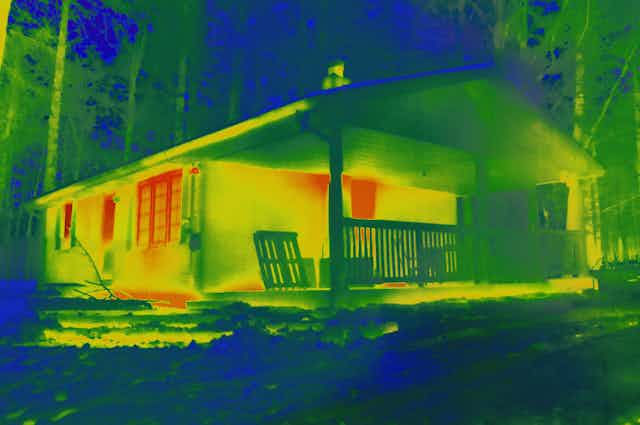Climate change and energy costs mean we need to rethink how we design and build our homes. The updated National Construction Code has lifted the required energy performance of new housing from 6 stars to 7 stars (10 stars being the best). Windows are an obvious focus for improving the energy efficiency of Australian homes.
On hot days, most of the heat that gets into our homes is through the windows. On cold days, windows account for almost half the heat loss. High-performance insulating windows have been installed in Australian homes at a fraction of the rates for New Zealand, the United States and the United Kingdom.
In our newly published report, we found the local window industry can produce the high-performance windows we need for thermally efficient homes. These homes will cost less to heat and cool, with lower greenhouse gas emissions.
But the industry is complex, with several obstacles to greater uptake of these windows. We identified a range of government policies and industry actions that could help drive change.
How much difference do windows make?
Single-glazed windows are common in Australian housing. Heat travels easily through these windows so they are a thermal weak spot.
In Australian homes, up to 87% of heat gain in summer and 40% of heat loss in winter is through the windows. This makes it harder to maintain a comfortable temperature inside.
Around 40% of household energy use in the average Australian home is for heating and cooling. The result is high power bills.

High-performance windows can solve this problem
Better windows are available. Double-glazed and triple-glazed windows offer much better performance, reducing the need to use energy for heating and cooling. In some climate zones, they’re one of the most cost-effective investments in energy efficiency you can make.
These windows have insulating layer(s) of air between the glass panes. Other elements can also improve performance. These include thermal breaks (an insulating barrier that reduces heat flow through the window frame) and films that can be applied to the panes.
These approaches can be used in new window units, or with retrofit options such as secondary glazing, which can be cheaper than replacing the whole window unit. It involves installing a glazed panel in a frame inside an existing window. This can be a great solution for apartments as it might not require owners corporation approval.
Read more: Keen to retrofit your home to lower its carbon footprint and save energy? Consider these 3 things
High-performance windows offer many benefits beyond greater thermal comfort. These include better physical and mental health as a result of homes no longer being too hot or too cold, improved control of ventilation and natural light, and reduced noise from outdoors.
Australia is trailing far behind other countries in installing high-performance windows. Just over 10% of windows in new housing in Australia are high-performance – versus around 80% in the United Kingdom, the United States and New Zealand.
Read more: We need a 'lemon law' to make all the homes we buy and rent more energy-efficient
Scaling up use of high-performance windows
We explored the window and residential building industry in Victoria on behalf of Sustainability Victoria. Our aim was to understand the industry and its readiness to scale up the manufacture, sale and installation of high-performance windows. We also wanted to understand what support might be needed to achieve this transition.

The people we spoke to, drawn from across the sector, said they are ready to scale up once demand is there. They clearly said there isn’t any technological barrier to doing this.
The time from ordering to receiving windows has increased in recent years as part of wider supply-chain issues. We were told this was almost resolved. However, a rapid scaling up of demand for high-performance windows could create short-term supply challenges.
The builders we spoke to identified some issues around understanding the various window products, such as the relative benefits of different frame materials. For example, uPVC and timber frames typically conduct less heat than aluminium. However, a thermal break can greatly improve aluminium frame performance.
They also noted that high-performance windows cost more. This can be a challenge in an industry already struggling to provide housing at affordable prices.
In addition, high-performance windows are heavier. Extra equipment could be needed to install them.
Read more: Will 7-star housing really cost more? It depends, but you can keep costs down in a few simple ways
How can policy help improve uptake?
We found the industry is complex. A range of measures will likely be needed to encourage the uptake and delivery of more high-performance windows. Our research proposes the following interventions:
regulation – further improve regulations to nudge use of high-performance windows, which could include setting minimum performance requirements for windows as New Zealand has done
education – better educate builders and consumers with easy-to-understand, transparent information to bust myths about high-performance windows and encourage people to consider their wider benefits
finance – there is a need to reduce capital costs (economies of scale will help) and improve access to government support, which could include rebates for home owners, similar to those for rooftop solar systems
quality assurance – the range of high-performance window options means we need to ensure key intermediaries like energy assessors provide well-informed advice. Support tools such as the Window Energy Rating Scheme can help with decision-making. There is also a need to ensure quality installation practices.
Windows for the future
Given the key role of windows in housing quality, performance and emissions, installing high-performance windows needs to become business as usual. In many other countries, double-or-triple-glazed windows are now standard. If we don’t do the same, we will lock households into lower-quality, poorly performing housing for decades.
Making high-performance windows standard building practice in Australia is achievable. However, some support for the window industry, builders and households will be needed.

